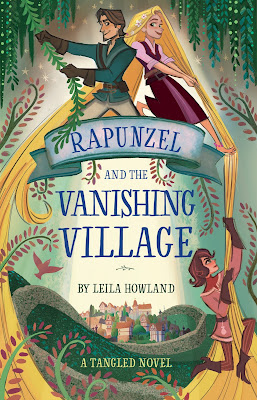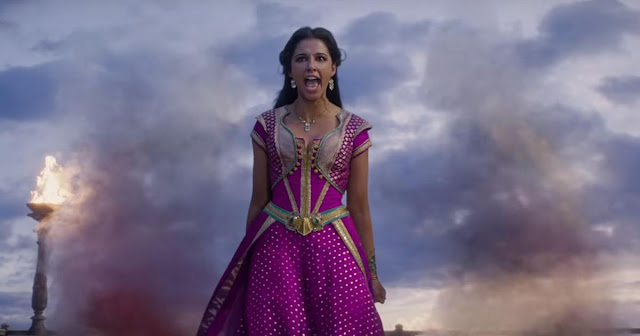Review: Rapunzel and the Vanishing Village
Did you know that the Tangled series might be in trouble? Despite boasting beautiful music, breathtaking artwork, and top-notch storytelling, it is reportedly one of the lowest rated shows on Disney Channel right now. Executive producer Chris Sonnenberg has been diligently reaching out to fans via Twitter to spread more visibility for the show. Loyal fans have also created a new Twitter page to share and discuss news about the series. Don't worry; we're still getting a third season. I just have no idea when. In solidarity of the recent efforts to promote the show, I did some research and discovered that there was a second tie-in novel released last year called Rapunzel and the Vanishing Village. I had already discovered the first tie-in novel, Rapunzel and the Lost Lagoon, when it was released thanks to an aggressive advertising campaign on Facebook. It did a fantastic job of bridging the gap between the original film and the series. Rapunzel and the Vanishing Village was also written by Leila Howland and takes place in between the first and second seasons of the show.
Like its predecessor, Rapunzel and the Vanishing Village is written in first person format and alternates between the perspectives of the main characters. While Rapunzel and the Lost Lagoon only portrays Rapunzel and Cassandra's viewpoints, Rapunzel and the Vanishing Village includes a third series of perspectives from Eugene. I wasn't entirely thrilled with this format because many of the chapters were very short. Sometimes the narrative voice would change every two or three pages, and I didn't always remember who was being referred to by the pronoun "I." This book probably would have worked better in the third person omniscient narrative without losing anything important from the plot. Despite that nitpick, Leila Howland demonstrates an excellent understanding of how the Tangled characters think and act. As soon as I began reading, it felt as though I had jumped right into an episode of the show. All of the dialogue was on point. The story moves just as fast as the cartoon without wasting much time on exposition even though there were plenty of new characters as well as a new locale with a dark secret.
Most of the story takes place at Harmony Glen, the birthplace of the Flynnigan Rider books that inspired Eugene's alter ego from before he met Rapunzel. After some investigating, the characters find their way to the magical home of the Author, where everything is a little too perfect in a "Stepford Wives" kind of way. They are instantly welcome with open arms, and Eugene is given the lead role of Flynn Rider in the town's upcoming play. Cassandra is, as usual, the first to suspect that things are not as they seem, but Rapunzel catches on soon after when she notices how the town leader, Joaquin, uses subtle brainwashing tactics to break the free will of its inhabitants and stunt their creativity. She grows more concerned when she hears reports about people who used to live in the town mysteriously disappearing. Eugene and Lance revel in their new roles in the town play and want nothing to do with the conspiracy until it affects Eugene's relationship with Rapunzel. One benefit of seeing Eugene's perspective is that it give us an opportunity to see just how much he loves Rapunzel.
The concept of a deceptively "nice" village reminded me a little too much of the last book in A Series of Unfortunate Events, but I think that the strength of Rapunzel and the Vanishing Village lies more in its characters than in its plot. In both novels, Leila Howland places a lot of focus on Rapunzel as an artist, something that the series often glosses over, especially in the second season. We often forget about the whimsical Claire Keane inspired paintings that Rapunzel creates in her journal they are overshadowed by the complex backstory of the Sun Drop and the Moonstone. These novelizations give Rapunzel the mind and soul of an artist who is constantly thinking about how she can best evoke the feeling, color, and form of the world around her on paper. Being an artist is one of the things that makes Rapunzel stand out the most from the other Disney Princesses, so I love reading about this side of her usual portrayal as a generic modern heroine who goes on lots of adventures. Eugene's devotion to the Flynn Rider stories comes full circle in this novel as he comes to terms with the fact that Flynn Riders is his past, but Rapunzel is his future. Cassandra's personality as an obsessive compulsive perfectionist shines through in this book as well. Even her pet owl gets an important role here, even though we rarely see him do anything in the show.
Overall, I think that Rapunzel and the Lost Lagoon is a more important book to the Tangled mythology than Rapunzel and the Vanishing Village. It reveals how Rapunzel and Cassandra met and bonded before the series began. That said, Rapunzel and the Vanishing Village does have its charms. It's a quick and fun read and provides a rare throwback to the inspiration behind Eugene's identity as Flynn Rider, something that the series almost never mentions. I do wish it had revealed more about the Author and background of the Flynnigan Rider books instead of giving us a generic tyrannical village conspiracy plot, but it was still a pleasant read. It presented sides of the characters that we rarely got to see in the second season and fit right in with the show's upbeat humor and colorful cast. If you need a quick Rapunzel fix while awaiting a release date for the show's third season, this book will do a good job of satiating your thirst.
Like its predecessor, Rapunzel and the Vanishing Village is written in first person format and alternates between the perspectives of the main characters. While Rapunzel and the Lost Lagoon only portrays Rapunzel and Cassandra's viewpoints, Rapunzel and the Vanishing Village includes a third series of perspectives from Eugene. I wasn't entirely thrilled with this format because many of the chapters were very short. Sometimes the narrative voice would change every two or three pages, and I didn't always remember who was being referred to by the pronoun "I." This book probably would have worked better in the third person omniscient narrative without losing anything important from the plot. Despite that nitpick, Leila Howland demonstrates an excellent understanding of how the Tangled characters think and act. As soon as I began reading, it felt as though I had jumped right into an episode of the show. All of the dialogue was on point. The story moves just as fast as the cartoon without wasting much time on exposition even though there were plenty of new characters as well as a new locale with a dark secret.
Most of the story takes place at Harmony Glen, the birthplace of the Flynnigan Rider books that inspired Eugene's alter ego from before he met Rapunzel. After some investigating, the characters find their way to the magical home of the Author, where everything is a little too perfect in a "Stepford Wives" kind of way. They are instantly welcome with open arms, and Eugene is given the lead role of Flynn Rider in the town's upcoming play. Cassandra is, as usual, the first to suspect that things are not as they seem, but Rapunzel catches on soon after when she notices how the town leader, Joaquin, uses subtle brainwashing tactics to break the free will of its inhabitants and stunt their creativity. She grows more concerned when she hears reports about people who used to live in the town mysteriously disappearing. Eugene and Lance revel in their new roles in the town play and want nothing to do with the conspiracy until it affects Eugene's relationship with Rapunzel. One benefit of seeing Eugene's perspective is that it give us an opportunity to see just how much he loves Rapunzel.
The concept of a deceptively "nice" village reminded me a little too much of the last book in A Series of Unfortunate Events, but I think that the strength of Rapunzel and the Vanishing Village lies more in its characters than in its plot. In both novels, Leila Howland places a lot of focus on Rapunzel as an artist, something that the series often glosses over, especially in the second season. We often forget about the whimsical Claire Keane inspired paintings that Rapunzel creates in her journal they are overshadowed by the complex backstory of the Sun Drop and the Moonstone. These novelizations give Rapunzel the mind and soul of an artist who is constantly thinking about how she can best evoke the feeling, color, and form of the world around her on paper. Being an artist is one of the things that makes Rapunzel stand out the most from the other Disney Princesses, so I love reading about this side of her usual portrayal as a generic modern heroine who goes on lots of adventures. Eugene's devotion to the Flynn Rider stories comes full circle in this novel as he comes to terms with the fact that Flynn Riders is his past, but Rapunzel is his future. Cassandra's personality as an obsessive compulsive perfectionist shines through in this book as well. Even her pet owl gets an important role here, even though we rarely see him do anything in the show.
Overall, I think that Rapunzel and the Lost Lagoon is a more important book to the Tangled mythology than Rapunzel and the Vanishing Village. It reveals how Rapunzel and Cassandra met and bonded before the series began. That said, Rapunzel and the Vanishing Village does have its charms. It's a quick and fun read and provides a rare throwback to the inspiration behind Eugene's identity as Flynn Rider, something that the series almost never mentions. I do wish it had revealed more about the Author and background of the Flynnigan Rider books instead of giving us a generic tyrannical village conspiracy plot, but it was still a pleasant read. It presented sides of the characters that we rarely got to see in the second season and fit right in with the show's upbeat humor and colorful cast. If you need a quick Rapunzel fix while awaiting a release date for the show's third season, this book will do a good job of satiating your thirst.












Comments